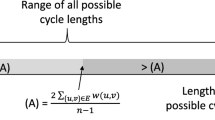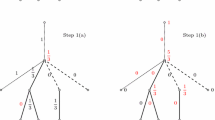Abstract
We consider the problem of deciding whether a given directed graph can be vertex partitioned into two acyclic subgraphs. Applications of this problem include testing rationality of collective consumption behavior, a subject in micro-economics. We identify classes of directed graphs for which the problem is easy and prove that the existence of a constant factor approximation algorithm is unlikely for an optimization version which maximizes the number of vertices that can be colored using two colors while avoiding monochromatic cycles. We present three exact algorithms, namely an integer-programming algorithm based on cycle identification, a backtracking algorithm, and a branch-and-check algorithm. We compare these three algorithms both on real-life instances and on randomly generated graphs. We find that for the latter set of graphs, every algorithm solves instances of considerable size within few seconds; however, the CPU time of the integer-programming algorithm increases with the number of vertices in the graph while that of the two other procedures does not. For every algorithm, we also study empirically the transition from a high to a low probability of YES answer as function of a parameter of the problem. For real-life instances, the integer-programming algorithm fails to solve the largest instance after one hour while the other two algorithms solve it in about ten minutes.
Access this chapter
Tax calculation will be finalised at checkout
Purchases are for personal use only
Preview
Unable to display preview. Download preview PDF.
Similar content being viewed by others
References
Ahuja, R.K., Magnanti, T.L., Orlin, J.B.: Network Flows: Theory, Algorithms, and Applications. Prentice-Hall, Englewood Cliffs (1993)
Apollonio, N., Franciosa, P.G.: A characterization of partial directed line graphs. Discrete Mathematics 307, 2598–2614 (2007)
Chen, Z.: Efficient algorithm for acyclic colorings of graphs. Theoretical Computer Science 230, 75–95 (2000)
Cherchye, L., De Rock, B., Vermeulen, F.: The collective model of household consumption: a nonparametric characterization. Econometrica 75, 553–574 (2007)
Cherchye, L., De Rock, B., Sabbe, J., Vermeulen, F.: Nonparametric tests of collectively rational consumption behavior: an integer programming procedure. Journal of Econometrics 147, 258–265 (2008)
Cormen, T.H., Leiserson, C.E., Rivest, R.L., Stein, C.: Introduction to Algorithms. The MIT Press, Cambridge (2005)
Deb, R.: Acyclic partitioning problem is NP-complete for k = 2. Private communication. Yale University, United States (2008)
Deb, R.: An efficient nonparametric test of the collective household model. Working paper. Yale University, United States (2008)
Farin, G.: Class A Bézier curves. Computer Aided Geometric Design 23, 573–581 (2006)
Hogg, T.: Refining the phase transition in combinatorial search. Artificial Intelligence 81, 127–154 (1985)
Monasson, R., Zecchina, R., Kirkpatrick, S., Selman, B., Troyansky, L.: Determining computational complexity from characteristic ‘phase transitions’. Nature 400, 133–137 (1999)
Talla Nobibon, F., Cherchye, L., De Rock, B., Sabbe, J., Spieksma, F.C.R.: Heuristics for deciding collectively rational consumption behavior. Research report ces08.24, University of Leuven (2008)
Talla Nobibon, F., Hurken, C., Leus, R., Spieksma, F.C.R.: Coloring graphs to avoid monochromatic cycles. University of Leuven (2009) (manuscript)
Tarjan, R.E.: Depth-first search and linear graph algorithms. SIAM Journal on Computing 2, 146–160 (1972)
Varian, H.: Revealed preference. In: Samuelsonian Economics and the 21st Century (2006)
Wu, Y., Yuan, J., Zhao, Y.: Partition a graph into two induced forests. Journal of Mathematical Study 1, 1–6 (1996)
Author information
Authors and Affiliations
Editor information
Editors and Affiliations
Rights and permissions
Copyright information
© 2010 Springer-Verlag Berlin Heidelberg
About this paper
Cite this paper
Talla Nobibon, F., Hurkens, C., Leus, R., Spieksma, F.C.R. (2010). Exact Algorithms for Coloring Graphs While Avoiding Monochromatic Cycles. In: Chen, B. (eds) Algorithmic Aspects in Information and Management. AAIM 2010. Lecture Notes in Computer Science, vol 6124. Springer, Berlin, Heidelberg. https://doi.org/10.1007/978-3-642-14355-7_24
Download citation
DOI: https://doi.org/10.1007/978-3-642-14355-7_24
Publisher Name: Springer, Berlin, Heidelberg
Print ISBN: 978-3-642-14354-0
Online ISBN: 978-3-642-14355-7
eBook Packages: Computer ScienceComputer Science (R0)




